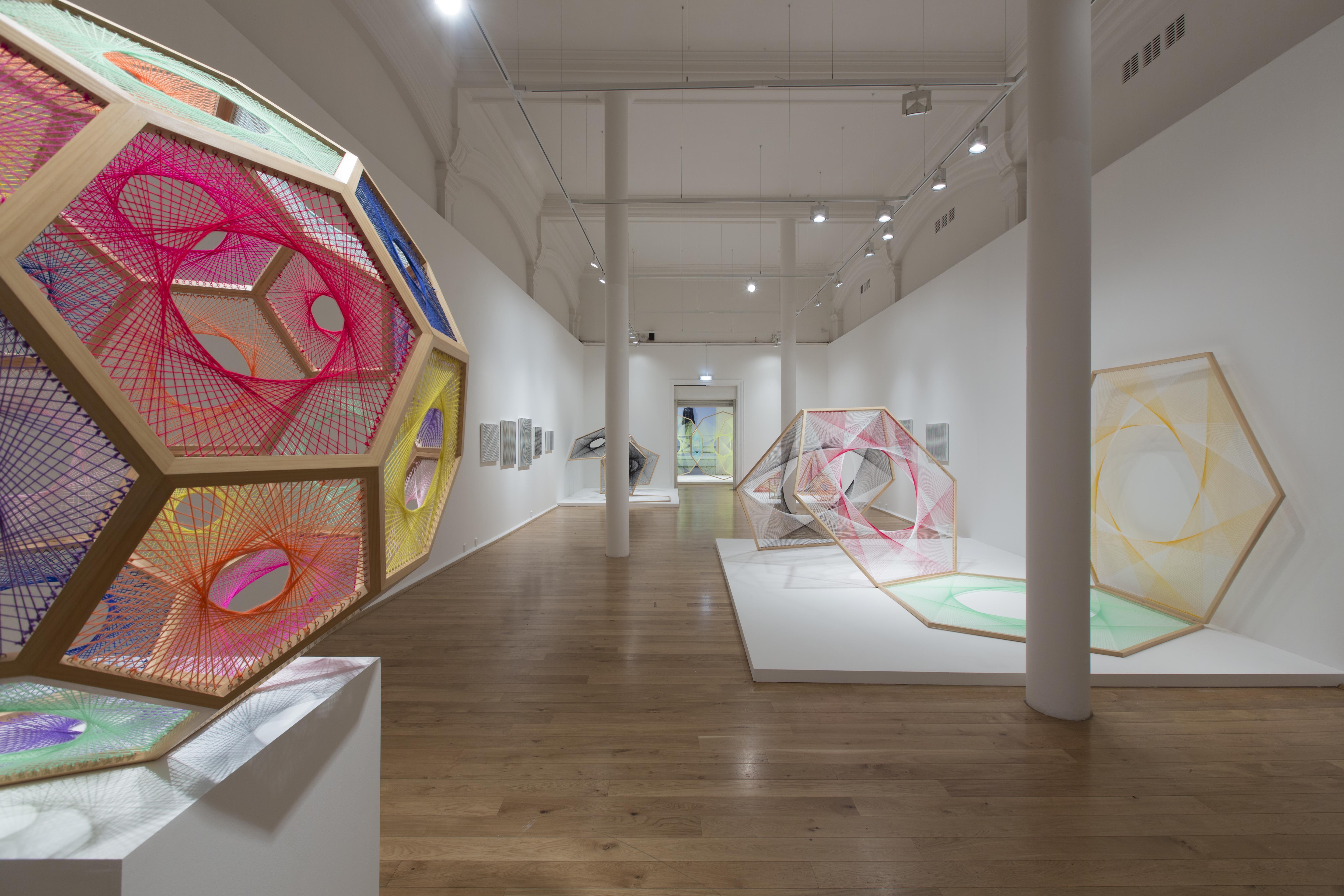
Text by David Iillington.
Five years ago Nike Savvas, very unusually, made five big figurative paintings. Her methods are always painstaking but for these they were especially so. She had doubts about the results. Since then the paintings, which are very good, have barely seen the light of day. They are not in this show, but they are relevant.
One has a Boucher detail surrounded by psychedelic swirls. In another Fragonard’s woman on a swing is isolated in abstract clouds. “She’s in her own ecstasy,” says Savvas. A third has flagellant monks, similarly engulfed by circles indicative, one supposes, of higher, or at least altered, mental states. They have irony along wth a genuine psychological charge. And they ask what it is to look at a painting. Once you grasp that whatever else she is doing, Savvas is always dealing with some relationship between experience and art, then you really begin to understand her work.
Writer Patricia Ellis [1] remarks that the strangest thing about these paintings is not the combination of patterns and appropriated figures, but their perfection, the smooth surfaces painted entirely with brushes. The technique. They also seem to depict sound. Which takes me to another aside, before I get to the show in question. I’ve seen Savvas’s methods first hand. I watched her and lighting engineer Dave Black put together a silent light show, light by light, programming each separately. It took them over a week, working into the night. Black’s lighting engineer friends laughed when he explained the technique, but they agreed the results were different and affecting. In a club the lights would be linked to the music through a computer.
The atmosphere in the darkened gallery was of two crafts meeting, and of relentless concentration. I don’t think she’ll mind me saying, Black, who was brilliant, did the actual work. Her vision drove the proceedings. The result, Anthem 2006 (Is That All There Is?) was the visual transcription of a song, according to the artist’s idea of it – and not a computer’s. [2] The assembly of Liberty and Anarchy at Leeds Art Gallery, took three technicians at least ten days, working flat out. Technicians aside, one might ally Savvas with other artists currently working in a craft-based mode. At the gallery’s ‘In Discussion’ session (Savvas with Patricia Ellis) one questioner understandably asked why she didn’t make more use of computers. (The same question Dave Black’s friends asked). Ellis cut in with “Nike doesn’t even have a mobile phone.” It’s true.
Artist and Leeds Art Gallery Assistant Fred Pepper told me about three mathematicians who came to see the show. They were entranced by the Sliding Ladder pieces, 3D geometrical constructions – some very large – with wooden frames tightly strung with brightly coloured woollen thread. They analysed the geometry, the beauty. They knew the maths Savvas had used to design them. Pepper: “some mathematicians and, say, molecular biologists, see the world in a way that is almost religious. There is what you could call a non-specific spiritual ecstasy some people get from seeing formulae or geometric forms – or just a really nice egg.” Savvas’s comment was, “so their being based on maths doesn’t make them bad after all!” What in fact makes them good is their ability to refer to so many things at once. I saw in them ideas about sculpture and home crafts. They examine craft, which might be said to glorify technique, and they connect art and a discipline, maths, which tries to unravel reality.
Liberty and Anarchy is a large and simple labyrinth, the high walls of which consist of hundreds of brightly coloured strips of plastic, attached above and below, a narrow gap between each vertical strip. The viewer walks through and is immersed in colour and the moiré effects created by seeing through the gaps to the next wall of strips. “There are two responses to colour,” says Savvas, “a cultural response and a psychological response.” The cultural response includes the idea of colour – it’s clear this piece acknowledges a history of artists who worked with colour and its psychology. And though sensation itself might be dwelt on, you see the piece properly if you also see it as an idea of sensation (and I think it still allows you to ask the question: is not nature, after all, always better?) It’s an idea expressed in a mixture of actual sensation, physical objects, and references to other things, ideas and artworks.
The artists Savvas mentions when I talk to her include Jesús Rafael Soto, Carlos Cruz-Diez, Oskar Fischinger, Len Lye, Julio le Parc. Cruz-Diez could be seen as an influence on Liberty and Anarchy, but so might many other artists. Bridget Riley? Savvas’s work has purity, simplicity, even a kind of innocence. But you would have to say that this type of purity, simplicity or innocence is also extremely allusive, complicated and sophisticated.
– [1] Patricia Ellis, Big Fat Greek Ozzy Sculpture, in Nike Savvas: Full of Love, Full of Wonder, Black Dog, 2012.
– [2] Anthem 2006 was made for Wild Gift, curated by myself and Rosie Cooper. The song was PJ Harvey’s version of the Leiber and Stoller classic.
Nike Savvas: Liberty and Anarchy ran between 07 December – 24 February at Leeds Art Gallery.
David lillington is a writer and curator based in London.
Published 14.04.2013 by Alexander Taber in Reviews
886 words